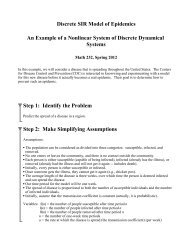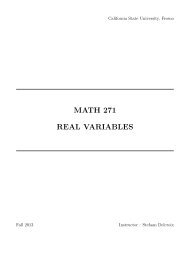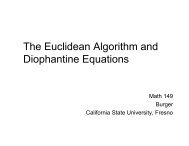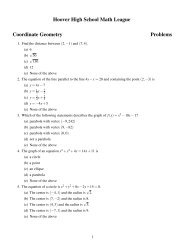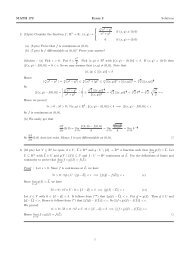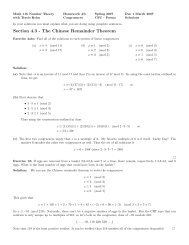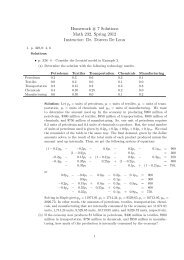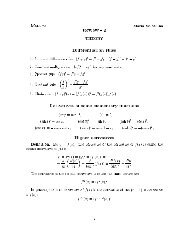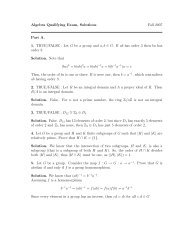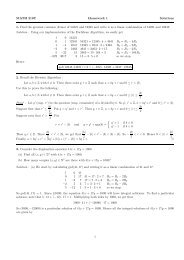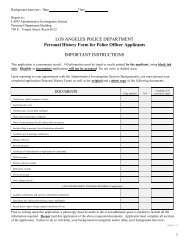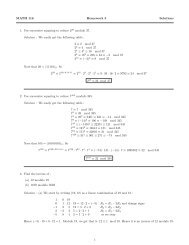MATH 251 Homework 2 Solutions 1. Prove that no two of the ...
MATH 251 Homework 2 Solutions 1. Prove that no two of the ...
MATH 251 Homework 2 Solutions 1. Prove that no two of the ...
You also want an ePaper? Increase the reach of your titles
YUMPU automatically turns print PDFs into web optimized ePapers that Google loves.
<strong>MATH</strong> <strong>251</strong> <strong>Homework</strong> 2 <strong>Solutions</strong><br />
<strong>1.</strong> <strong>Prove</strong> <strong>that</strong> <strong>no</strong> <strong>two</strong> <strong>of</strong> <strong>the</strong> multiplicative groups (Q ∗ , ·), (R ∗ , ·) and (C ∗ , ·) are isomorphic.<br />
Pro<strong>of</strong> : Since Q ∗ is countable and R ∗ and C ∗ are uncountable and an isomorphism is a bijection, we see <strong>that</strong><br />
(R ∗ , ·) ≁ = (Q ∗ , ·) ≁ = (C ∗ , ·).<br />
Suppose <strong>that</strong> θ : C ∗ → R ∗ is an isomorphism. Note <strong>that</strong> i is an element in C <strong>of</strong> order four. Then x := i θ is<br />
an element in R <strong>of</strong> order four. So x 4 = <strong>1.</strong> Hence x = 1 or x = −<strong>1.</strong> In particular, <strong>the</strong> order <strong>of</strong> x is <strong>no</strong>t four, a<br />
contradiction. So (C ∗ , ·) ≁ = (R ∗ , ·).<br />
✷<br />
2. This exercise is about S 4 .<br />
(a) Write down how many elements S 4 has <strong>of</strong> each cycle type (like elements <strong>of</strong> <strong>the</strong> form (ab) or (abc) etc.).<br />
(b) <strong>Prove</strong> <strong>that</strong> Z(S 4 ) = {e} (hint : for each cycle type σ , find an element in S 4 <strong>that</strong> does <strong>no</strong>t commute with<br />
σ).<br />
Solution : (a) We easily get <strong>the</strong> following :<br />
e : 1<br />
(ab) :<br />
( 4<br />
6 =<br />
2)<br />
( ) 4 3!<br />
(abc) : 8 =<br />
3 3<br />
(abcd) : 6 = 4!<br />
4<br />
(ab)(cd) : 3 = 1 ( 4<br />
2 2)<br />
(b) Note <strong>that</strong><br />
(ab)(abc) = (ac) and (abc)(ab) = (bc)<br />
So (ab), (abc) /∈ Z(S 4 ). We also have <strong>that</strong><br />
(abcd)(ab)(cd) = (bd) and (ab)(cd)(abcd) = (ac)<br />
So (abcd), (ab)(cd) /∈ Z(S 4 ).<br />
Hence Z(S 4 ) = {e}.<br />
✷<br />
3. Let K be a field. <strong>Prove</strong> <strong>that</strong> SL(n, K) ✂ GL(n, K) and <strong>that</strong> GL(n, K)/SL(n, K) ∼ = K ∗ .<br />
Pro<strong>of</strong> :<br />
Consider <strong>the</strong> map<br />
θ : GL(n, K) → K ∗ : A → det(A)<br />
Note <strong>that</strong> det(A) ≠ 0 and so det(A) ∈ K ∗ if A ∈ GL(n, K).<br />
• θ is a homomorphism<br />
Let A, B ∈ GL(n, K). Using a well-k<strong>no</strong>wn property <strong>of</strong> determinants, we get <strong>that</strong><br />
θ(AB) = det(AB) = det(A) det(B) = θ(A)θ(B)<br />
1
• θ is onto<br />
Pick a ∈ K ∗ . Put<br />
Then A ∈ GL(n, K) and θ(A) = det(A) = a.<br />
• Ker θ = SL(n, K)<br />
Let A ∈ GL(n, K). Then<br />
Hence Ker θ = SL(n, K).<br />
⎡<br />
⎤<br />
a 0 0 · · · 0<br />
0 1 0 · · · 0<br />
A =<br />
0 0 1 · · · 0<br />
⎢<br />
⎣<br />
.<br />
. . . ..<br />
⎥<br />
0 ⎦<br />
0 0 0 · · · 1<br />
A ∈ Ker θ ⇐⇒ θ(A) = 1 ⇐⇒ det(A) = 1 ⇐⇒ A ∈ SL(n, K)<br />
It follows <strong>that</strong> SL(n, K) = Ker θ ✂ GL(n, K). By <strong>the</strong> First Isomorphism Theorem, we get<br />
GL(n, K)/SL(n, K) = GL(n, K)/Ker θ ∼ = Im θ = K ∗<br />
4. Let G be a group, H ≤ G and N ✂ G. <strong>Prove</strong> <strong>that</strong> HN = NH ≤ G.<br />
Pro<strong>of</strong> : Pick y ∈ HN. Then y = hn for some h ∈ H and some n ∈ N. Since N ✂ G, we have <strong>that</strong> hN = Nh.<br />
So y = hn ∈ hN = Nh ⊆ NH. Hence HN ⊆ NH.<br />
Pick y ∈ NH. Then y = nh for some h ∈ H and some n ∈ N. Hence y = nh ∈ Nh = hN ⊆ HN. Hence<br />
NH ⊆ HN.<br />
So HN = NH.<br />
Pick x 1 , x 2 ∈ HN. Then x 1 = h 1 n 1 and x 2 = h 2 n 2 for some h 1 , h 2 ∈ H and some n 1 , n 2 ∈ N. Hence<br />
So HN ≤ G by <strong>the</strong> Subgroup Test.<br />
x 1 x −1<br />
2 = (h 1 n 1 )(h 2 n 2 ) −1 = h 1 n 1 n −1<br />
2 h−1 2 ∈ HNH = HHN = HN<br />
✷<br />
5. Let G be a group and H ≤ G such <strong>that</strong> [G : H] = 2. <strong>Prove</strong> <strong>that</strong> H ✂ G.<br />
Pro<strong>of</strong> : Pick g ∈ G. If g ∈ H, <strong>the</strong>n clearly gH = H = Hg. So assume <strong>that</strong> g /∈ H. Then {H, gH} (resp.<br />
{H, Hg}) are <strong>the</strong> <strong>two</strong> left (resp. right) cosets <strong>of</strong> H in G. Since <strong>the</strong> cosets form a partition <strong>of</strong> G, we have <strong>that</strong><br />
gH = G \ H = Hg. In ei<strong>the</strong>r case, we get <strong>that</strong> gH = Hg. So H ✂ G.<br />
✷<br />
6. Let G be a group. <strong>Prove</strong> <strong>that</strong> Z(G) char<br />
✂ G.<br />
Pro<strong>of</strong> :<br />
Let θ ∈ Aut(G). It is e<strong>no</strong>ugh to show <strong>that</strong> θ(Z(G)) ⊆ Z(G) by Proposition <strong>1.</strong>19b.<br />
Pick x ∈ Z(G). Let g ∈ G. Since θ : G → G is an isomorphism (and hence onto), we have <strong>that</strong> g = θ(h) for<br />
some h ∈ G. Using <strong>the</strong> fact <strong>that</strong> x ∈ Z(G) and θ is a homomorphism, we find<br />
θ(x)g = θ(x)θ(h) = θ(xh) = θ(hx) = θ(h)θ(x) = gθ(x)<br />
Since g was arbitrary, we get <strong>that</strong> θ(x) ∈ Z(G). So θ(Z(G)) ⊆ Z(G).<br />
✷<br />
7. True/False : Let G be a group and A ✂ B ✂ G. Then A ✂ G.<br />
Solution : False. Let G = D 4 , B = {e, r 2 , s, r 2 s} and A = {e, s}. Then A, B ≤ G. Since [G : B] = [B : A] = 2,<br />
we get <strong>that</strong> A ✂ B ✂ G. But r −1 sr = sr 2 /∈ A. Hence A is <strong>no</strong>t a <strong>no</strong>rmal subgroup <strong>of</strong> G.<br />
✷<br />
2



